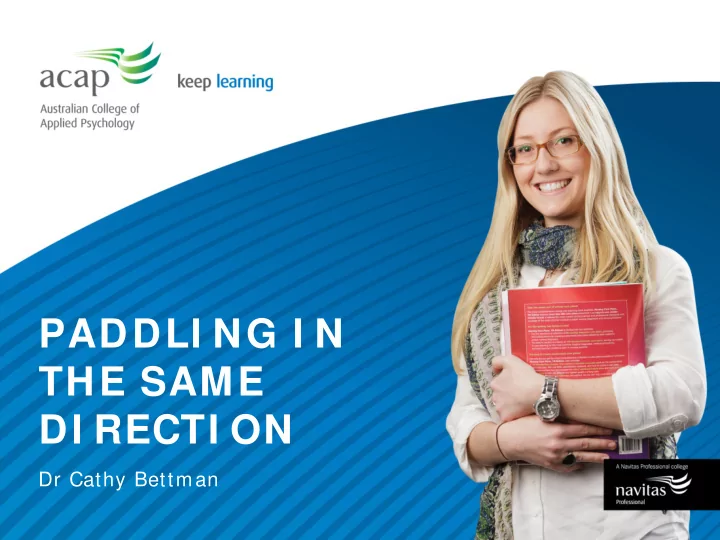

PADDLI NG I N THE SAME DI RECTI ON Dr Cathy Bettman
Gehart (2014, p. 135), Mastering Competencies in Family Therapy Just as in m arriage, in w hich a com m itm ent to one person entails a com m itm ent to an entire fam ily, once you decide to com m it to a theory, you are also com m itting to the broader philosophy that is the theory’s foundation. I believe therapists w ho are clear about their philosophy of w hat it m eans to be hum an ( ontology) and how people learn and change ( epistem ology) are best positioned to handle the variety of problem s w ith w hich skilled therapists m ust learn to w ork. Once you com m it yourself to a theory and philosophical stance, it ironically becom es m uch easier to dance w ith others . acap.edu.au navitas.com
Bertrando (2007), The Dialogical Therapist: Dialogue in Systemic Practice Bertrando ( 2 0 0 7 ) contends that theoretical purism is a m yth and that anyone w orking in the counselling field undergoes innum erable influences throughout their personal and professional lives. An epigenetic m odel The idea of substitution being im possible Every change in theory or practice connects up w ith those experiences that have proven them selves useful Not a sim ple linear process of accum ulating new ideas over tim e, but rather … a system of concepts and of experiences recursively connected and in continual evolution acap.edu.au navitas.com
Still Bertrando (2007) I n our w ork w e find inspiration in the m eaningful voices to w hich w e have been exposed during our professional career I n accordance w ith our epigenetic view , w e integrate w ithin our m ore recent version of the system ic m odel, the theories learned in the past and all the m eaningful ‘voices’ professional or sim ply hum an) that inspire us in our daily practice and life. acap.edu.au navitas.com
My inspiration - briefly Lifeline and Carl Rogers Empathy, Unconditional Positive Regard and Congruence Not much about the Actualizing Tendency, the Organismic Valuing Process or Conditions of Worth or External Locus of Evaluation acap.edu.au navitas.com
And then: Relationships Australia (NSW) in the glorious 90’s Post – Milan – with emphasis on the Post! From Milan: Moving away from pathology The importance of context Circular causality as against lineal Behaviour having a function – and being positively connoted acap.edu.au navitas.com
Curiosity Neutrality Hypothesising The art of curious questions The idea of the therapist as a participant in the therapeutic system Perturbation and re-organisation Just by the way, there was still very much an element of strategic expertise, hierarchy, the therapist as content expert, intervener and privileged meta-knower (Anderson, 1997, 4) acap.edu.au navitas.com
And then the Post! Acknowledging Gehart (2014, pp 138-139) Social Constructionist ideas Reality Objectivity is not possible Knowledge and truth constructed within and between people – culturally, historically and relationally bound Truth and reality constructed by language and relationships Language and w ords describe m eaning but also m ake m eaning Language is generative, gives order and meaning to our lives and our world, and functions as a form of social participation (Anderson, 2007, 3) Societal and political influences – dominant discourses acap.edu.au navitas.com
And the Post grew! Learning different languages Solution Focused Questions as taps on the shoulder Narrative The work of Harlene Anderson and Harry Goolishian – Conversation, language and Possibilities (1997) Paolo Bertrando – the Dialogical Therapist – “Someone whose therapy is guided by the use of systemic hypotheses but who also works in a more collaborative manner, in dialogue, to produce a hypothesis actively created by both therapist and clients” Open Dialogue – Jaakko Seikkula (Finland) acap.edu.au navitas.com
In the words of Anderson (2007, 4) where it has led me epigenetically A system contextually based and a product of social communication We are a system of individuals who are in a relationship through language A philosophical stance inviting a collaborative relationship and process A collaborative partnership between people with different perspectives and expertise acap.edu.au navitas.com
The therapist as a not-knower in a being- informed position – the therapist is uncertain and regards knowledge as evolving A therapist as an expert in creating a dialogical space and facilitating a dialogical process A focus on generating possibilities and relying on the contributions and creativity of all participants acap.edu.au navitas.com
A shared inquiry that relies on the expertise of all persons participating in a conversation A therapist who is public about, shares, and reflects on his or her knowledge, assumptions, thoughts, questions, and opinions Change – as evolving through and the natural consequence of a generative dialogue and collaborative relationship A therapist and a client as co-investigators who participate in creating what they “find”. acap.edu.au navitas.com
Case Study acap.edu.au navitas.com
Recommend
More recommend